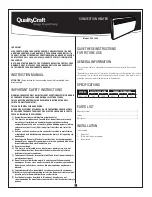
INSTALLATION INSTRUCTIONS
R
−
410A Split System Heat Pumps
428 01 1703 01
7
Specifications subject to change without notice.
Compressor Crankcase Heater
When equipped with a crankcase heater and outdoor
ambient is below 40
F (4.4
°
C), furnish power to heater a
minimum of 24 hr before starting unit. To furnish power to
heater only, set thermostat to OFF and close electrical
disconnect to outdoor unit.
A crankcase heater is required if refrigerant tubing is longer
than 80 ft. (24.38 m). Refer to the Long Line Applications
Guideline.
Install Electrical Accessories
Refer to the individual instructions packaged with kits or
accessories when installing.
Check OAT Thermistor and OCT Thermistor
Attachments
Outdoor Air Temperature (OAT) Thermistor is factory installed
by inserting the nibs on either sides of the thermistor body
through a keyhole in the bottom shelf of the control box and
locking it in place by turning it 90 degrees, such that the
spherical end of a nib faces the front of the control box.
Check to make sure the OAT is locked in place. See Fig.8.
Figure 8
Outdoor Air Thermistor (OAT) Attachment
DX+ DX- C
OAT Thermistor must be locked
in place with spherical nib end facing
towards the front of the control box.
The Outdoor Coil Temperature (OCT) Thermistor is factory
installed on the 3/8” diameter stub tube located on the coil
assembly. Check to make sure that it is securely attached
with the clip as shown in Fig. 9.
Figure 9
Outdoor Coil Thermistor (OCT) Attachment
OCT Thermistor
must be secured
tight on stub tube.
Airflow Setup with Observer Communicating
Furnace or Fan Coil
When using an Observer Communicating Wall Control and
communicating indoor equipment, airflow is automatically
selected based on equipment size. See Observer Wall
Control Installation Instructions and indoor specification sheet
for available adjustments.
Airflow Setup with Non-Communicating
Furnace or Fan Coil
Two
−
stage compressor operation requires two different
indoor airflow settings for proper operation. This outdoor unit
is designed for use only with an indoor blower that can be
configured for separate low
−
stage and high
−
stage airflow
(CFM) levels. Refer to Product Specifications Sheets for
recommended low
−
stage and high
−
stage indoor airflow
values.
Refer to indoor unit Installation Instructions to set the indoor
blower for the proper low
−
stage and high
−
stage airflow
values.
NOTE: Optimal comfort, efficiency, and reliability will only be
achieved when the indoor airflow is properly set for both
low
−
stage and high
−
stage operation.
START
−
UP
CAUTION
!
UNIT OPERATION AND SAFETY HAZARD
Failure to follow this caution may result in minor personal
injury, equipment damage or improper operation.
To prevent compressor damage or personal injury,
observe the following:
Do not overcharge system with refrigerant.
Do not operate unit in a vacuum or at negative
pressure.
Do not disable low pressure switch in scroll compressor
applications.
Dome temperatures may be hot.
CAUTION
!
PERSONAL INJURY HAZARD
Failure to follow this caution may result in personal injury.
Wear safety glasses, protective clothing, and gloves
when handling refrigerant and observe the following:
Front seating service valves are equipped with
Schrader valves.
CAUTION
!
ENVIRONMENTAL HAZARD
Failure to follow this caution may result in environmental
damage.
Federal regulations require that you do not vent refrigerant
to the atmosphere. Recover during system repair or final
unit disposal.
Follow these steps to properly start up the
system:
1. After system is evacuated, fully open liquid and vapor
service valves.
2. Unit is shipped with valve stem(s) front seated (closed)
and caps installed.


































